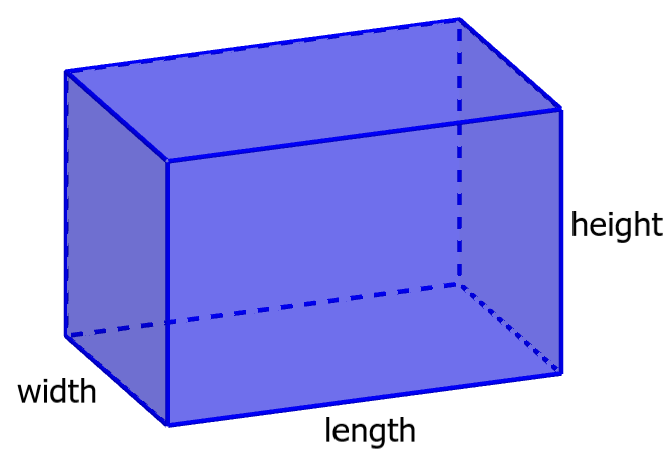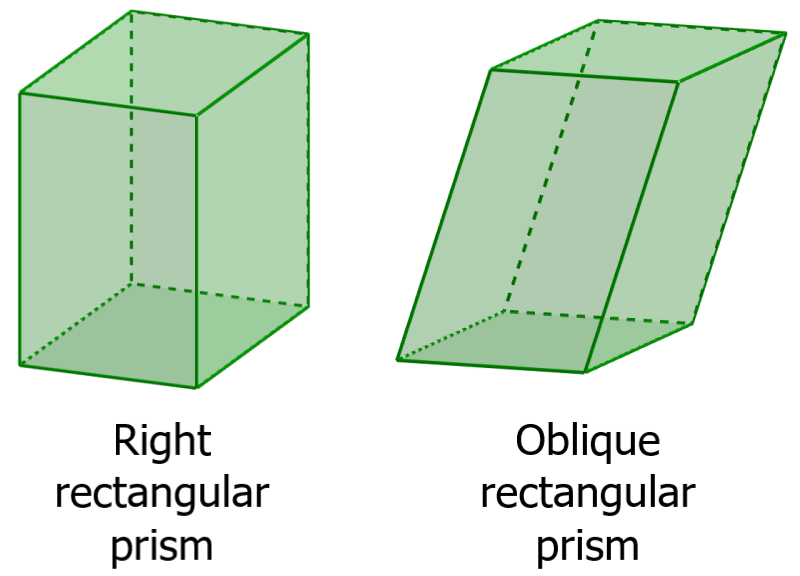A rectangular prism is a three-dimensional figure that is composed of two parallel rectangular bases and four rectangular faces. We can also consider rectangular prisms as cuboids or as polyhedra with two congruent parallel bases. Since the rectangular prism is a 3D figure, its most important properties are volume and surface area.
Here, we will learn about some of the most important characteristics of a rectangular prism. Also, we will learn about its most used formulas and we will apply them to solve some problems.
GEOMETRY

Relevant for…
Learning about the characteristics of rectangular prisms.
GEOMETRY

Relevant for…
Learning about the characteristics of rectangular prisms.
Definition of a rectangular prism
A rectangular prism is a three-dimensional figure. Rectangular prisms have six faces in total, and all of their faces are shaped like a rectangle. These prisms are also known as cuboids.

Rectangular prisms can be classified into two main types:
- Right rectangular prisms
- Oblique rectangular prisms
Right rectangular prism
A right rectangular prism is a prism that has six faces that are right angles and in which all the internal angles are right, that is, they have 90 degrees.
Oblique rectangular prism
An oblique prism is a prism in which the bases are not perpendicular to the lateral faces. In an oblique rectangular prism, the bases are not aligned one above the other directly.

Fundamental characteristics of a rectangular prism
The following are the fundamental characteristics of rectangular prisms:
- They have 6 rectangular faces.
- They have 12 edges.
- They have 8 vertices.
- These prisms have rectangular cross sections.
- All opposite faces are equal.
- A right rectangular prism has all its angles with 90 degrees.
- They are also called cuboids.
Important rectangular prism formulas
The most important formulas for rectangular prisms are the volume formula, the surface area formula, and the diagonal formula.
Formula for the volume of a rectangular prism
The volume of a rectangular prism is calculated by multiplying the three lengths of its dimensions:
| $latex V=b\times l\times h$ |
where b represents the length of the base, l represents the length of the width, and h represents the length of the height.
Formula for the surface area of a rectangular prism
The surface area is equal to the sum of the areas of all the faces of the prism. Considering that the opposite faces are equal, we have:
| $latex A_{s}=2(bl+lh+bh)$ |
Formula for the diagonal a rectangular prism
We use the Pythagorean theorem in three dimensions to calculate the length of the diagonal:
| $latex d=\sqrt{{{b}^2}+{{l}^2}+{{h}^2}}$ |
Examples of rectangular prism problems
The formulas indicated above are used to solve the following exercises.
EXAMPLE 1
A rectangular prism has a base of 7 m, a width of 6 m, and a height of 5 m. What is its volume?
Solution: We use the values $latex b=7$, $latex l=6$, and $latex h=5$ in the volume formula. Therefore, we have:
$latex V=blh$
$latex V=(7)(6)(5)$
$latex V=210$
The volume of the prism is 210 m³.
EXAMPLE 2
A prism has a base of 5 m, a width of 4 m, and a height of 6 m. What is its surface area?
Solution: We have the lengths $latex b=5$, $latex l=4$ and $latex h=6$. Therefore, using the formula for the surface area with these values, we have:
$latex A_{s}=2(bl+lh+bh)$
$latex A_{s}=2((5)(4)+(4)(6)+(5)(6))$
$latex A_{s}=2(20+24+30)$
$latex A_{s}=2(74)$
$latex A_{s}=148$
The surface area is 148 m².
EXAMPLE 3
What is the diagonal of a rectangular prism that has a base of 5 m, a width of 4 m, and a height of 6 m?
Solution: We have the lengths $latex b=5$, $latex l=4$ and $latex h=6$. Using these values in the formula, we have:
$latex d=\sqrt{{{b}^2}+{{l}^2}+{{h}^2}}$
$latex d=\sqrt{{{5}^2}+{{4}^2}+{{6}^2}}$
$latex d=\sqrt{25+16+36}$
$latex d=\sqrt{77}$
$latex d=8.77$
The length of the diagonal is 8.77 m.
See also
Interested in learning more about rectangular prisms? Take a look at these pages:



